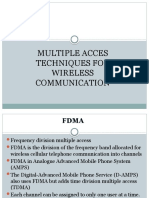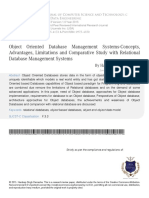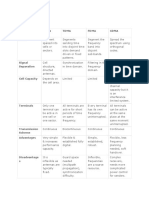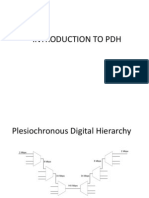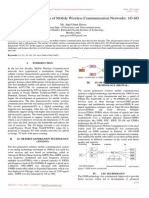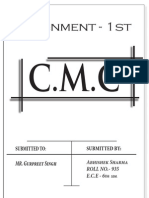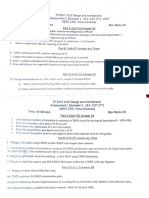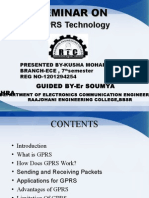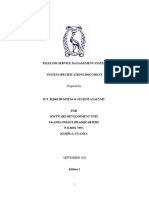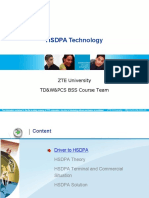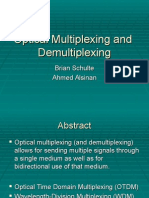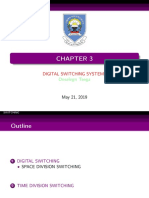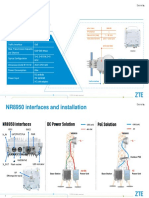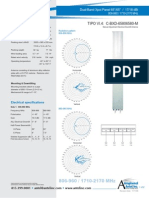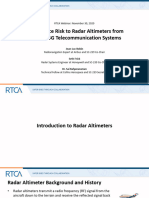NEW TRENDS IN WIRELESS COMMUNICATION TECHNOLOGY
(WITH SUITABLE MULTIPLE ACCESS)
Manoj Kr. Shukla Assistant Professor Dept. of Electronics Engineering
Harcourt Butler Technological Institute
Kanpur 208002 Email: manojs@hbti.ac.in, manojkrshukla@rediffmail.com
Question
The EM spectrum is a limited resource
How can we share it?
Time Space Frequency Polarization Spread Spectrum - use a wider bandwidth?
Multiple Access techniques
Goal
allow many users to simultaneously share a communications resource
Time Division Multiple Access (TDMA) Space Division Multiple Access (SDMA) Frequency Division Multiple Access (FDMA) Polarization Division Multiple Access (PDMA) Code Division Multiple Access (CDMA) Interleave Division Multiple Access (IDMA) Orthogonal Frequency Division Multiple Access
Key Issue
separate the signals at the receiver to
extract your information
Two methods Do not mix the signals in the first place
can use space or time (SDMA or TDMA)
Use distinctive properties of each signal as a
means to identify
Frequency spectrum (FDMA) Polarization of waves (PDMA) code sequence attached to each message (CDMA)
International Cocktail Party
FDMA Large room divided up into small rooms with
limited microphones. Each pair of people takes turns speaking.
TDMA Large room divided up into small rooms with
limited microphones. Certain pairs of people per room, however, each pair gets limited seconds to speak.
CDMA No small rooms. Everyone is speaking in
different languages with own microphones. If voice volume is minimized, the number of people is maximized.
Definitions
TDMA Time Division Multiple Access FDMA Frequency Division Multiple Access CDMA Code Division Multiple Access IDMA- Interleave Division Multiple Access
General Specification of TDMA
Rx: 869-894MHz Tx: 824-849MHz 832 Channels spaced 30kHz apart
(3 users/channel) DQPSK modulation scheme 48.6kbps bit rate Interim Standard (IS) 54 Digital AMPS (Advanced Mobile Phone System) Uses Time Division Duplexing (TDD) usually
TDMA Details
The incoming data from each source are
briefly buffered and scanned to to form a composite digital data stream mc ( t ) .
Buffer Buffer Frame mc ( t )
preamble preamble
U1 U2
m1 ( t ) m2 ( t )
Frame
1 2
...
1 2
Time slot
UN
mN ( t )
Buffer
Scan operation
information
Each slot may be empty or occupied. + has preamble & guard bits
TDMA System
Each user receives half of
the frame and the full bandwidth.
Interval of Interest
Users can resolve both multipath
s0 h1
s0 h2 s1 h1 s1 h2 s2 h1 s2 h2
Time allocation is
independent of power allocation. Nonlinear ISI cancellation.
Cancel edge effects as well.
TDMA Block Diagram
User 1 Data Estimate Channel
Channel
ISI Cancellation
Equalize
Detect and Decode
User 2 Data Output
Advantages of TDMA
Flexible bit rate No frequency guard band required No need for precise narrowband filters Easy for mobile or base stations to initiate and execute hands off Extended battery life TDMA installations offer savings in base station equipment, space and maintenance The most cost-effective technology for upgrading a current analog system to digital
Disadvantages to using TDMA
Requires network-wide timing
synchronization Requires signal processing fro matched filtering and correlation detection Demands high peak power on uplink in transient mode Multipath distortion
General Specification of FDMA
Rx: 869-894MHz Tx: 824-849MHz 832 Channels spaced 30kHz apart
(3 users/channel) DQPSK modulation scheme 48.6kbps bit rate Used in analog cellular phone systems (i.e. AMPS) Uses Frequency Division Duplexing (FDD) ISI (Intersymbol Interference) is low
Advantages of FDMA
Channel bandwidth is relatively narrow (30kHz) Simple algorithmically, and from a hardware
standpoint Fairly efficient when the number of stations is small and the traffic is uniformly constant Capacity increase can be obtained by reducing the information bit rate and using efficient digital code No need for network timing No restriction regarding the type of baseband or type of modulation
Disadvantages to using FDMA
The presence of guard bands Requires right RF filtering to minimize
adjacent channel interference Maximum bit rate per channel is fixed Small inhibiting flexibility in bit rate capability Does not differ significantly from analog system If channel is not in use, it sits idle
SDMA
Space Division Multiple Access
Use highly directional
The receiver selects the beam that provides the greatest signal enhancement and interference reduction Smart antenna systems can adjust their antenna pattern to enhance the desired signal, null or reduce interference.
Desired Signal Direction
SDMA Pros and Cons
Advantages BW increases with km2 Disadvantages Restricted Geometry
terminals in same direction cannot share
Simple system
May have unused BW
if no terminals in given zone, bw not used
PDMA
Polarization Division Multiple Access
Two methods
Two antennas with orthogonal polarizations an antenna with dual-polarization (SATCOM)
Each polarization provides one separate
channel
PDMA Pros and Cons
Advantages doubles BW Disadvantages Large specialized Ae
Spread Spectrum
CDMA - FHMA - DSMA - SSMA
Definition - Spread Spectrum
The transmission bandwidth must be much
larger than the information bandwidth
The resulting RF bandwidth is determined
by a function other than the information being sent
Spread Spectrum - illustrated
Power Density Conventional Transmission
PDi
same total power
Spread Spectrum Transmission
PDSS Bi
BSS
How
Two main methods
Frequency Hopped Multiple Access (FHMA) Direct Sequence Multiple Access (DSMA) THMA does exist, but not common
Both depend on pseudo random
orthogonal codes often called pseudo noise
FHSS
Frequency Hopping Multiple Access
message is "cut" into small "chunks"
Each chunk is modulated by a different fc
(determined by pseudo-random code)
A band pass filter accepts the signals that
follow the hopping sequence and rejects all other requires synchronization predictable patterns
note - some early systems used short
FHSS - illustrated
Frequency
Frequency Hop Tune Time Dwell Time
Time
DSMA
Direct Sequence Multiple Access
Each bit is chipped Example - time domain
Data
0.1 ms
1 bit
0.1 s
Chips
1000 chips
Requires much wider bandwidth
Cross Correlation
Mathematical process used to determine the
similarity between two signals
15-bit Code Received Signal Modulo-2 sum
111101011001000 011110101100100
100011110101100
Correlation = -1/15 (very poor)
Used for despreading
to determine start of code to lock onto correct code
Pseudo Random Orthogonal...
Different sequences are said to be
orthogonal if they do not interfere with one another (ie have low cross correlation)
A sequence is pseudo random if it is
orthogonal with a time shifted version of itself number of codes available << 2 n -1
note - this significantly reduces the
Spreading Process
Info
Noise Info Signal
Baseband Signal
Before spreading
Transmitted (Coded) Signal
After spreading
How can you recover signal < noise
SNR gain of spread spectrum
The ratio of the SNR out to the SNR into
the demodulator ( spreading factor).
GP =
SNRout SNRin
BWRF Rinfo
Example
Given: 1 Mcps PN code 1 kbps information data signal
BW
RF
6
= 2 MHz
G = 2 x 10 = 2000 = 33 dB p 3 10
This means that after de-spreading, signal is 33 dB (2000 times) bigger than the noise.
General Specification of CDMA
Rx: 869-894MHz Tx: 824-849MHz 20 Channels spaced 1250kHz apart
(798 users/channel) QPSK/(Offset) OQPSK modulation scheme 1.2288Mbps bit rate IS-95 standard Operates at both 800 and 1900 MHz frequency bands
CDMA Operation
Spread Spectrum Multiple
Access Technologies
Sender A
CDMA in theory
sends Ad = 1, key Ak = 010011 (0= -1, 1= +1) sending signal As = Ad * Ak = (-1, +1, -1, -1, +1, +1)
Sender B
sends Bd = 0, key Bk = 110101 (0= -1, 1= +1) sending signal Bs = Bd * Bk = (-1, -1, +1, -1, +1, 1)
Both signals superimpose in space
interference neglected (noise etc.) As + Bs = (-2, 0, 0, -2, +2, 0)
Decoding CDMA
Receiver wants to receive signal from sender A
apply key Ak bitwise (inner product) Ae = (-2, 0, 0, -2, +2, 0) Ak = 2 + 0 + 0 + 2 + 2 + 0 =
6 result greater than 0, therefore, original bit was 1
receiving B Be = (-2, 0, 0, -2, +2, 0) Bk = -2 + 0 + 0 - 2 - 2 + 0 = 6, i.e. 0
CDMA Encode/Decode output Z channel
sender
data bits code
d0 = 1 d1 = -1
1 1 1 -1 1 -1 -1 -1 1 1 1 -1
Zi,m= di.cm
i,m
1 -1 -1 -1 -1
1 1 1 1 1 1 -1
1 -1 -1 -1
1 -1 -1 -1
slot 1
slot 0
slot 1 channel output
slot 0 channel output
Di = S Zi,m.cm
m=1
received input code
1 -1 -1 -1 -1
1 1 1 1 1 1 -1
1 -1 -1 -1
M
d0 = 1 d1 = -1
1 1 1 -1
1 -1 -1 -1
1 1 1 -1
1 -1 -1 -1
receiver
slot 1
slot 0
slot 1 channel output
slot 0 channel output
CDMA: two-sender interference
MC-CDMA System
Complex orthogonal spreading
Full Bandwidth s1c11f1 s2c21f1 s1c12f2 s2c22f2
codes. Length 2 Spread over two subcarriers. Both users use full bandwidth and full frame. Each subcarrier is flat fading Code allocation and spreading length is independent of power allocation.
User 1 User 2
First Subcarrier
Second Subcarrier
Half Bandwidth
Multicarrier CDMA
The data is serial-to-parallel converted. Symbols on each branch spread in time. Spread signals transmitted via OFDM Get spreading in both time and frequency
c(t)
S/P convert
s(t)
IFFT c(t) P/S convert
MC-CDMA Block Diagram
User 1 Data Spread IFFT Estimate Channel
Channel
Interference Cancellation
FFT
Equalize
Spread
IFFT
Despread
User 2 Data
Detect and Decode
Output
DS-CDMA System
Complex, orthogonal spreading
codes.
Symbol Interval
s1c11h s1c12h
Synchronous transmission Users can resolve both
multipath components. Nonlinear interference cancellation
Length 2
User 1 User 2
s2c21h
s2c22h
Code assignment and
ISI Other user
Chip Interval
spreading length are independent of power allocation.
DS-CDMA Block Diagram
User 1 Data Spread Estimate Channel
Channel
Interference Cancellation
Despread
Equalize
User 2 Data
Spread
Detect and Decode
Output
Capacity
CDMA has the ability to deliver 10 to 20
times the capacity as FDMA for the same bandwidth. CDMA also has a capacity advantage over TDMA by 5 to 7 times.
TD-SCDMA development
Datang Telecommunication
technology (former China Academy of Telecommunication Technology) is the most active TD-SCDMA developer The biggest manufacturers have formed number of Joint Ventures for TD-SCDMA R&D The Chinese Government has already invested more than 1 billion (US$123.3 million) in the research and development (R&D) of TD-SCDMA Domestic companies have got heavy public subsidies for TDSCDMA development
TD-SCDMA developer pool
TD-SCDMA
Pros:
ITU standard, belongs to
Cons:
Standard development far
behind rivals. Standard is very immature, no commercial use so far No large scale support from industry. Only few TDSCDMA chips available Lack of equipments and handsets. No mass production. No uniform platform for applications -> No application developer pool Some unsolved technical problems:
Cell interference large cell area functions high speed mobility poor stability of existing ICs Power consumption of handsets
3GPP TDD technology, fully compatible with GSM and GPRS Easy to upgrade from existing infrastructure Efficient use of spectrum Effective data transmission. Asynchronous uplink downlink, suitable for Internet traffic Use of Smart Antenna technology Good mobility: > 120 km/h Large cells, with diameter up to 40 km
5. Third Generation Mobile 5.3 TD-SCDMA
TD-SCDMA forum
Industry consortium devoted to develop
and support TD-SCDMA technology Established in Dec/2000 by China Mobile, China Telecom, China Unicom, Datang, Huawei, Motorola, Nortel and Siemens More than 420 members
16 Board Members 18 Senior Members 390 ordinary members
Advantages of CDMA
Many users of CDMA use the same frequency,
TDD or FDD may be used Multipath fading may be substantially reduced because of large signal bandwidth No absolute limit on the number of users Easy addition of more users Impossible for hackers to decipher the code sent Better signal quality No sense of handoff when changing cells
Disadvantages to using CDMA
As the number of users increases, the
overall quality of service decreases Self-jamming Near- Far- problem arise higher complexity of a receiver all signals should have the same strength at a receiver
near and far terminals
Terminals A sends and B receives
signal strength decreases proportional to the square of the distance the signal of terminal B therefore drowns out As signal
Comparison SDMA/TDMA/FDMA/CDMA
Approach Idea SDMA
segment space into cells/sectors
TDMA
segment sending time into disjoint time-slots, demand driven or fixed patterns all terminals are active for short periods of time on the same frequency synchronization in the time domain
FDMA
segment the frequency band into disjoint sub-bands
CDMA
spread the spectrum using orthogonal codes
Terminals
only one terminal can be active in one cell/one sector cell structure, directed antennas
every terminal has its own frequency, uninterrupted filtering in the frequency domain simple, established, robust inflexible, frequencies are a scarce resource
Signal separation
all terminals can be active at the same place at the same moment, uninterrupted code plus special receivers flexible, less frequency planning needed, soft handover complex receivers, needs more complicated power control for senders
Advantages very simple, increases established, fully
capacity per km digital, flexible
Disadvantages
inflexible, antennas typically fixed
Comment
only in combination with TDMA, FDMA or CDMA useful
guard space needed (multipath propagation), synchronization difficult standard in fixed networks, together with FDMA/SDMA used in many mobile networks
typically combined with TDMA (frequency hopping patterns) and SDMA (frequency reuse)
still faces some problems, higher complexity, lowered expectations; will be integrated with TDMA/FDMA
CDMA Design Considerations
Bandwidth limit channel usage to 5 MHz Chip rate depends on desired data rate, need for
error control, and bandwidth limitations; 3 Mcps or more is reasonable Multirate advantage is that the system can flexibly support multiple simultaneous applications from a given user and can efficiently use available capacity by only providing the capacity required for each service
CDMA2000 Pros and Cons
Evolution from original Qualcomm CDMA
Now known as cdmaOne or IS-95 Better migration story from 2G to 3G cdmaOne operators dont need additional spectrum 1xEVD0 promises higher data rates than UMTS, i.e. W-CDMA Better spectral efficiency than W-CDMA(?) Arguable (and argued!) CDMA2000 core network less mature cmdaOne interfaces were vendor-specific Hopefully CDMA2000 vendors will comply w/ 3GPP2
W-CDMA (UMTS) Pros and Cons
Wideband CDMA
Standard for Universal Mobile Telephone Service (UMTS) Committed standard for Europe and likely migration path for other GSM operators Leverages GSMs dominant position Requires substantial new spectrum 5 MHz each way (symmetric) Legally mandated in Europe and elsewhere Sales of new spectrum completed in Europe At prices that now seem exorbitant
TD-SCDMA
Time division duplex (TDD) Chinese development
Will be deployed in China Good match for asymmetrical traffic! Single spectral band (1.6 MHz) possible Costs relatively low Handset smaller and may cost less Power consumption lower TDD has the highest spectrum efficiency Power amplifiers must be very linear Relatively hard to meet specifications
IMT-2000 Radio Standards
IMT-SC* Single Carrier (UWC-136): EDGE
GSM evolution (TDMA); 200 KHz channels; sometimes called 2.75G
IMT-MC* Multi Carrier CDMA: CDMA2000
Evolution of IS-95 CDMA, i.e. cdmaOne
IMT-DS* Direct Spread CDMA: W-CDMA
New from 3GPP; UTRAN FDD
IMT-TC** Time Code CDMA
New from 3GPP; UTRAN TDD
New from China; TD-SCDMA
IMT-FT** FDMA/TDMA (DECT legacy)
* Paired spectrum; ** Unpaired spectrum
Some Requirements for Future Wireless Systems
low receiver cost de-centralized (i.e., asynchronous) control, simple treatment of ISI, cross-cell interference mitigation, diversity against fading, power efficiency (long battery life), multi-media services (e.g., mixed voice and IP), high user number, high throughput and high spectral efficiency,
FDMA TDMA CDMA
Dept. of Electronics & Communication Engineering
57
Evolution of IDMA
A conventional CDMA system requires separate coding
and spreading operations.
Verdu and Viterbi [2]* has shown that the optimum
multiple channel capacity (MAC) is achievable only when entire bandwidth is devoted to coding.
This suggests combining the coding and spreading operations using low-rate codes to maximize coding gain.
Dept. CDMA with random *S. Verd and S. Shamai, Spectral efficiency of of Electronics &
spreading, IEEE Trans. Inform. Theory, vol. 45, pp. 622640, Mar. 1999
Communication Engineering
58
Evolution of IDMA..
Possible Solution for User Separation Narrow band coded-modulation scheme using trellis code structures [4]
To employ chip-level interleavers [3][4][5][6]
Improvement in CDMA scheme by assigning different interleavers to different users [5]*[6]**
*A. Tarable,et al, Analysis and design of interleavers for CDMA systems, IEEE Commun. Lett., vol. 5,, Oct. 2001. **S. Brck, U. Sorger, S. Gligorevic, and N. Stolte, Interleaving for outer convolutional Dept. of Electronics & codes in DSCDMA Systems, IEEE Trans. Commun.,July 2000.
Communication Engineering
59
Conventional CDMA Transmitter and an Iterative MUD Receiver
Encoder (C) User 1 Interleaver Spreader 1 Multiple Access Multipath Channel Encoder (C) User K Interleaver Deinterleaver User1 Decoder Interleaver Turbo Processor Deinterleaver User K Decoder Interleaver Elementary Multi-User Detector (EMUD) Spreader K
Correlator Bank
Dept. of Electronics & Communication Engineering
60
IDMA Transmitter and Receiver structures
Encoder (C) User 1 CODER Spreader Interleaver 1 Multiple Access Multipath Channel Spreader Interleaver K r(j)
Encoder (C) User K
User 1
Decoder (DEC)
Turbo Processor
Deinterleaver 1 Interleaver 1
eESE (x1 (j)) eDEC (x1 (j)) eESE (xK (j)) Elementary Signal Estimator (ESE)
Deinterleaver K Decoder User K (DEC)
Dept. of Electronics & Communication Engineering
Interleaver K
eDEC (xK (j))
61
Categories of Wireless Networks
Beyond 100 meters WWAN : WLAN : WMAN : Wide Area Connectivity Local Area Connectivity Metro Area Connectivity (Broad geographic 100 meters (City or suburb) coverage)
WPAN : Personal Area Connectivity 10 meters
Bluetooth, UWB
WiFi, HiperLan
WiMax
AMPS, GSM, IS-95 cdma2000, W-CDMA
<source : Wireless communication technology landscape, DELL >
Digital Technology
Frequency-shift keying (FSK)
- uses two frequencies (one for 1s & the other for 0s) - alternates between the two frequencies modulation and encoding schemes - convert the analog ->digital, compress it>analog - acceptable level of voice quality maintained Cell phones need a lot of processing power
Cellular vs. PCS
digital cellular,
paging, caller ID and email
Frequency
Cellular PCS
824MHz894 MHz 1850 MHz-1990
MHz
PCS has smaller cells
and larger number of antennas.
Channel spacing Time slots
30 KHz 3
200 KHz 8
Dual band, Dual mode Triband, Trimode
What is Dual band?
What is Triband? Dual Mode
CDMA digital cellular (800 MHz) or CDMA digital PCS (1900 MHz).
GSM 900, 1800 and 1900 (MHz)
AMPS and TDMA Analog and digital Two digital (CDMA and TDMA) and analog Two bands in digital and analog
Trimode
WWAN (Wireless Wide Area Network)
1G 2G
IS-136/ PDC TDMA
2.5G
EDGE TDMA
3G
3.5G
4G
NMT TACT FDMA
W-CDMA GSM TDMA GPRS TDMA CDMA
W-CDMA/ HSDPA CDMA
IDMA
? OFDM
AMPS FDMA
IS-95 CDMA
IS-95B CDMA
cdma2000 CDMA
cdma2000 EV,DO,DV CDMA
Analog FDMA TDMA CDMA Voice 64~384K Packet
Digital OFDM
~2M Multimedia
~10M Multimedia
~100M Multimedia
Can be Implemented by Programmable DSP
No fully programmable H/W solutions
The FUNDAMENTAL Issue: Network Congestion
Congestion, at one of many points, can block a call !
Local Exchange Networks
AT&T MCI SPRINT
Local Exchange Networks
Mobile Switch
Government Emergency Telecommunications Service addresses wireline congestion
Mobile Switch
Wireless Priority Service addresses wireless congestion at call origination and call termination
Key Resource
Spectrum:
802.11 operates in the unlicensed band (ISM Industrial Scientific and Medical band) ~ 3 such bands Cordless Telephony: 902 to 928 MHz 802.11b: 2.4 to 2.483 GHz 3rd ISM Band: 5.725 to 5.875 GHz 802.11a: 5.15 to 5.825 GHz
Data Rates and Range
802.11: 2Mbps (Proposed in 1997) 802.11b: 1, 2, 5.5 and 11 Mbps, 100mts.
range (product released in 1999, no product for 1 or 2 Mbps)
802.11g: 54Mbps, 100mts. range (uses
OFDM; product expected in 2003)
802.11a: 6 to 54 Mbps, 50mts. range (uses
OFDM)
2G+ networks (contd.)
HSCSD one step towards 3G wideband mobile data networks. This circuit switched technology improves data rates up to 57.6 kbps. GPRS packet based and designed to work in parallel with 2G GSM, PDC and TDMA technologies. EDGE enhances the throughput per timeslot for both HSCSD and GPRS. ECSD (max data rate 64 kbps and EGPRS data rate per time slot triples to a staggering 384 kbps.
EDGE Cheaper and Gives Near-3G Performance
Modem GSM/TDMA Analog Modem GPRS ISDN CDMA 1x EDGE DSL W-CDMA Cable Technology 2G Wireless Fixed Line Dial-up 2.5G Wireless Fixed Line Digital 2.75G Wireless 2.75G Wireless Fixed Line DSL 3G Wireless Fixed Line Cable Throughput <9.6 Kbps 9.6 Kbps 30-40 Kbps 128 Kbps 144 Kbps 150 - 200 Kbps 0.7 - 1.5 Mbps 1.0 Mbps 1.0 - 2.0 Mbps 1 MB File Download Speed ~20 min 16 min 4.5 min 1.1 min 50 sec 36 to 47 sec 1 to 3 sec 1.5 sec 0.8 to 1.5 sec
EDGE is 2.75G, with significantly higher data rates than
GPRS Deploying EDGE significantly cheaper than deploying WCDMA Takeaway: Look for EDGE to gain traction in 2002/2003+
Upgrade Cost, By Technology
2G
2.5G / 2.75G
Software/Hardware Cost GSM GPRS Software-based Incremental W-CDMA Hardware-based Substantial CDMA CDMA 1x Hardware-based Substantial cdma2000 Software-based Incremental TDMA GSM/GPRS/EDGE Hardware and software Middle of the road W-CDMA Hardware-based Middle of the road
3G
Software/Hardware Cost
CDMA upgrade to 2.75G is expensive; to 3G is cheap GSM upgrade to 2.5G is cheap; to 3G is expensive TDMA upgrade to 2.5G/3G is complex Takeaway: AT&T and Cingular have a difficult road to 3G
3G CDMA Reported* Subscribers (As of March 30, 2007)
85 80 75 70 65 60 55 50 45 40 35 30 25 20 15 10 5 0
Mar Apr May June July
88.2 million 6.46 million 4.31 million
Subscribers (M)
Aug
Sep
Oct
Nov
Dec
Jan
Feb
Mar
Source: www.3Gtoday.com
3G CDMA is Well Established & Growing
Now in Use in Two Flavors: CDMA2000 and WCDMA
Worldwide CDMA Subscriber Evolution Forecast
Over 800M Subscribers, 205 Operators, 74 Countries, 530 Handsets, 63 Vendors
(Millions)
800 700 600 500 400 300 200 100 0 2000 2001 2002 2003
Future
September >174M subs
2004
2005
2006
2007
2008
2G CDMA
3G CDMA
3G WCDMA
Source: Strategy Analytics, April 2003 and www.3gtoday as of December 2003, CDG September 2003
Latest Trends and Driving Factors
High Intensity Multi-Media
Push to See
Capabilities More efficiency in multi-media content delivery
Enhancements to support Quality
of Service
Samsung SCH V310
Efficient and flexible Packet based
Video Telephony
5500
6500
Support for VoIP and Low-latency applications,
e.g., Gaming applications
Instant Multi Media (IMM)
Broadcast and Multicast services High Speed Data on both Up and Down Links
3G CDMA Evolution
Designed for In-Band Migration and New Spectrum
1.25 MHz
Optimized for Data
3G CDMA
CDMA2000 1xEV-DO
IS-856, Rel. 0 Enhancements Rel. A
Dedicated & Optimized For Packet Data 2.4 Mbps Peak Rates All IP Architecture
QoS, Broadcast, Personal Media, IMM ,2x
Fwd & Rev. Capacity Gains
Forward Link: Peak Rate 3.1 mbps
Reverse Link: Peak Rate 1.8 mbps
2G CDMA
2.5G CDMA
Additional voice capacity doubling - Terminal antenna diversity
1.25 MHz In - Band
Voice & Data
cdmaOne Migration and
IS - 95A IS-95B 64 kbps packet data Channel Concatenation
CDMA2000 1X
IS-2000 Rel. 0 Double voice capacity Fast Fwd Power Control Coherent Uplink 153.6 kbps packet data Turbo Codes Rel. A 307 kbps packet data Rel. B Rel. C
1xEV-DV
Rel. D Forward Link: Peak Rate: 3.1 mbps Reverse Link: Peak Rate: 1.8 mbps
14.4 kbps data Soft Handoff Synchronous Timing
Simultaneous voice and data
Improvements to data services. More flexible data packet scheduling.
Designed for New Spectrum
5 MHz
Voice & Data
UMTS (WCDMA)
HSDPA
Rel. 5
EUL
3GPP Rel. 99
Rel. 4
Rel. 6
64/384 kbps cs/packet data Improvements Enhanced to data services Up-Link Soft handoff Asynchronous timing More flexible data packet scheduling
1995 1999 2000 2001 2002 2003 2004 2005 2006
Migration To 3G
2.5G 2G 1G
Analog Voice
GSM GPRS
2.75G
Intermediate Multimedia Packet Data
3G
Multimedia
Digital Voice
W-CDMA (UMTS)
EDGE
115 Kbps
NMT
9.6 Kbps
384 Kbps
Up to 2 Mbps
TDMA TACS
9.6 Kbps
GSM/ GPRS
(Overlay) 115 Kbps
TD-SCDMA
2 Mbps?
iDEN
9.6 Kbps
iDEN PDC
9.6 Kbps (Overlay)
AMPS CDMA
14.4 Kbps / 64 Kbps
CDMA 1xRTT PHS
(IP-Based)
cdma2000
1X-EV-DV
144 Kbps
Over 2.4 Mbps
PHS
64 Kbps
1984 - 1996+
1992 - 2000+
2001+
2003+
2003 - 2004+
Source: U.S. Bancorp Piper Jaffray
CDMA2000 Standards Status
IS-95A/B
cdma2000 family
Done Done Done Done Done
1x Release 0
1x/3x Release A
1x/3x Release B
1x Revision C
(1xEV-DV FL)
1x Revision D
(1xEV-DV RL)
Publish Date: March 2006
Done
1xEV-DO Revision 0
1xEV-DO Revision A
Publish Date: March 2006
Arrow denotes evolution of standard, maintaining backward compatibility
CDMA2000 Compatibility
CDMA2000 Revision C is fully backward compatible:
IS-95A or newer mobile stations can operate in a Revision C cell 1xEV-DV capable mobiles can do data on older systems
F-PDCH
F-SCH
Base Station supporting Revision C
Mobile Mobile Station Station supporting supporting Revision C Revision C
Base Station supporting Revision 0
Key Factors to Better Performance
Capacity Improvement
Higher Data Rates and Finer Quantization
Data rates ranging from 4.8 kbps to 1.8 Mbps Smoother rate transitions and interference variation
Improved code rates and higher order modulation for large packets
QPSK modulation introduced Data channel spreading uses either or both of 2-ary and 4ary Walsh code channel
Code rate 1/5 for all 16-slot packets
Hybrid ARQ with IR
Enables packet to early terminate in the presence of
channel variation and imperfect power control
Biggest Threat to Todays 3G Wireless LANs
Faster than 3G
11 or 56 Mbps vs. <2 Mbps for 3G when stationary
Data experience matches the Internet
With the added convenience of mobile Same user interface (doesnt rely on small screens) Same programs, files, applications, Websites.
Low cost, low barriers to entry Organizations can build own networks
Like the Internet, will grow virally
Opportunity for entrepreneurs! Opportunity for wireless operators?
Critical For 3G Continued Growth In China
Likely 3G licensing outcomes: China Unicom cdma2000 China Mobile WCDMA China Telecom WCDMA/ TD-SCDMA? China Netcom WCDMA/ TD-SCDMA?
Risk:
CDMA IS-95 (2G) has been slow to launch in China
Why would the launch of 3G be any different?
PHS (2G) with China Telecom/Netcom is gaining
momentum
Mobile Standard Organizations
Mobile Operators ITU Members ITU GSM, W-CDMA, UMTS Third Generation Patnership Project (3GPP) IS-95), IS-41, IS2000, IS-835
CWTS (China)
Third Generation Partnership Project II (3GPP2)
ARIB (Japan) TTC (Japan) TTA (Korea) ETSI (Europe) T1 (USA) TIA (USA)
UWB Technology & Advantages
Doesnt need licensed dedicated spectrum Low power consumption Small semiconductor size Ranging/location as a byproduct of
communications
Questions ?
Manoj Kr. Shukla Assistant Professor Dept. of Electronics Engineering Harcourt Butler Technological Institute Kanpur 208002
Email: manojs@hbti.ac.in, manojkrshukla@rediffmail.com
